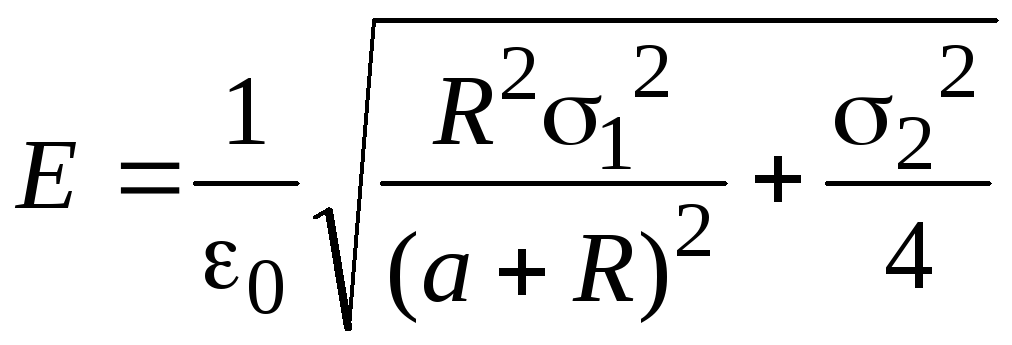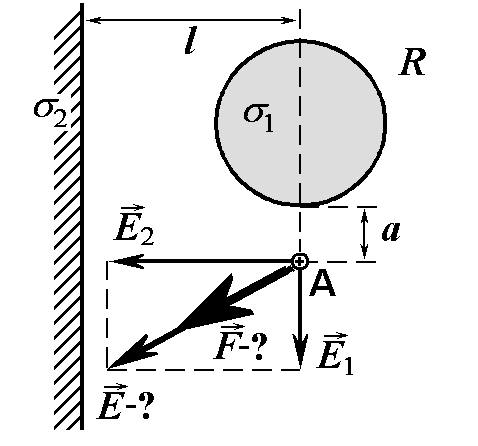
- •---------------------------
- •Module structure Module № 1. „ Electrical current and magnetic field of a current” – 72 hours total
- •List of practical training
- •Introduction
- •Problem 1.1. The principle of superposition of electric fields main concepts
- •Examples of problem solution
- •Individual tasks for problem 1.1. The principle of superposition of electric fields
- •Table of task variants
- •Problem 1.5. Direct current main concepts
- •Example of problem solution
- •Individual tasks for problem 1.5. Branched circuits
- •Table of task variants Table 1.5
- •The pictures for problem 1.5
- •Problem 2.1 the principle of magnetic fields’ superposition main concepts
- •Examples of problem solution
- •Individual tasks for problem 2.1 the principle of magnetic fields’ superposition
- •Table of task variants Table 2.1
- •* See Figures for problem 2.1.
- •Examples of problem solution
- •Individual tasks for problem 2.4. The law of electromagnetic induction
- •Tables of task variants
- •Bibliography
- •Physics
Problem 1.1. The principle of superposition of electric fields main concepts
Electric field is usually described by two basic quantities – vector of electric intensity and electric potential
![]() ;
;
![]() ,
,
where ![]() – force acted with a test point charge q0,
which is located in the given point of a field; Wn
– potential energy of a charge q0
, in
the given point.
– force acted with a test point charge q0,
which is located in the given point of a field; Wn
– potential energy of a charge q0
, in
the given point.
Intensity and potential of electric field of the point charge q at a distance of r of the charge
![]() ;
;
![]() ,
,
where 0 = 8,8510–12 F/m – permittivity of vacuum; – relative permittivity of medium (for air =1).
For the uniform field the dependence between the intensity and potential of the electric field
![]() ,
,
where r1,2 – the distance between equipotential lines with the potentials 1 and 2, E – the electric intensity in the middle of the equipotential lines with the potentials 1 and 2.
The modulus of electric field intensity:
1) uniformly charged sphere with a radius of R at a distance of r from the centre of sphere
а) E = 0, for r < R;
б) ![]() ,
for r ³
R,
,
for r ³
R,
where Q=S – a charge of sphere, – surface charge density of sphere (charge of 1m2 of a surface), S=4R2 – surface area of sphere.
2) endless uniformly charged cylinder with a radius of R at a distance of r from the axis of the cylinder.
а) E = 0, for r < R ;
б) ![]() for r ³
R,
for r ³
R,
where Q=L – a charge of cylinder, – linear charge density (charge of 1m of a length), L– length of cylinder.
3) endless uniformly charged plate
![]() ,
,
– surface charge density of plate.
The superposition principle: the electric field created by one charge is independent from positions of other charges. Then the resultant vector is a vector sum of vectors of electric field individual charges:
![]() ,
,
therefore:
a) the direction of the resultant vector is defined by parallelogram rule of the vectors’ additions (see example 1);
b) the magnitude of the resultant vector is defined by cosine theorem:
![]() ,
,
where – angle between vectors.
The electrostatic force acting on a test charge q
F=qERES.
Examples of problem solution
Example 1. The sphere with radius R=5 cm and the endless uniformly plate are charged from the surfaces with the charge density 1=10 nC/m2 and 1=–15 nC/m2 correspondingly. The sphere’s centre is situated on a distance of ℓ=10 cm from the plate. Find the electric intensity at the point А, which is situated on a distance of а=5 cm from the sphere’s surface and b=10 cm from the plate; force, which will act on the point charge q0=0,1 nC, if it is put to the point А.
|
Input data: 1=10 nC/m2=1010–9 C/m2 2=–15 nC/m2=–1510–9 C/m2 R=5 cm =510–2 m l=10 см =1010–2 м а=5cm=510–2m b=10cm=1010–2m q0=0,1 nC=0,110–9 C |
|
|
Find: Е, F – ? |
Solution:
According to the principle of superposition of electric fields: the sphere creates the electric field irrespective of the plate position in the space, and vice versa: the plate electric field is independent of the sphere position. That’s why the resultant intensity equals the vector sum of the individual intensities:
![]() .
.
a) We must show the direction of the resultant vector of electric intensity defined by parallelogram rule to the diagrammatic drawing (see picture).
b) We define the magnitude of the resultant vector by cosine theorem:
![]() .
.
Let’s find the individual intensities creating with the sphere and plate.
The sphere’s field intensity is in the point at a distance of r from its centre
![]() (1)
(1)
where 0=8.8510-12F/m – the vacuum permittivity; Q1 – the charge of sphere.
Let’s find the charge of the sphere through the surface charge density s1 and the area of sphere surface S=4R2:
![]() .
.
In this equation from the point А to the centre of the sphere distance r is defined as a sum of the distance a to the surface of sphere and radius of sphere R.
Inserted these expressions in the formula (1), we’ll get
 .
(2)
.
(2)
The plate electric intensity of the uniformly charged with the surface density s2
![]() .
(3)
.
(3)
The vector ![]() is directed along to field line from the sphere, as the sphere is
positively charged. The vector
is directed along to field line from the sphere, as the sphere is
positively charged. The vector ![]() is directed to the plate, as the plate is negatively charged.
is directed to the plate, as the plate is negatively charged.
As the vector ![]() and vector
and vector ![]() are mutually perpendicular and
cos90О=0,
then cosine theorem is transformed to a
Pythagorean theorem:
are mutually perpendicular and
cos90О=0,
then cosine theorem is transformed to a
Pythagorean theorem:
![]() . (4)
. (4)
Putting (2) and (3) in (4) and removing a common factor 1/0 beyond the radicand, we’ll get
 . (5)
. (5)
2. The magnitude of force, which is exerted with
the point charge ![]() ,which
is situated in the electrostatic field, is defined with the formula
,which
is situated in the electrostatic field, is defined with the formula
![]() (6)
(6)
We check if the formula (5) gives unit of intensity V/m, and the formula (6) the unit of force N.
![]() ;
;
![]()
Let's make substitution in the formulas (5) and (6) the value of quantities in the units of SI-system and make the evaluations
![]()
![]()
A direction of force coincides
with a direction of vector![]() .
(as
.
(as ![]() ),
that is shown in the picture.
),
that is shown in the picture.
Results:
![]() ,
,
![]()
Example 2. The air cylindrical capacitor consists of two coaxial cylinders with radiuses R1 =1 cm and R2 =3 cm. The length of the cylinders is L=50 cm. The capacitor was charged with the voltage U=100 V.
Find: 1) the electro capacity of capacitor; 2) field intensity in the capacitor at a distance of r=2 cm from the axle of the cylinders.
|
Input data: R1= 1cm =0,01m; R2=3cm = 0,03m; L=50 cm =0.5m; U=100 V; r =2cm =0,02m; |
|
|
Find: С; E – ? |
Solution:
The electro capacity of the air (=1) cylindrical capacitor can be found with the formula
![]() (1)
(1)
where 0=8.8510-12F/m – the vacuum permittivity; L – the length of cylinders; R1 and R2 – radiuses of cylinders.
Let’s find the vector of electric intensity at the distance of r from the axle of cylinders, at the point А, we’ll use the principle of superposition of electric fields
![]() ,
,
where ![]() – electric intensity at the point А,
created with the inner cylinder;
– electric intensity at the point А,
created with the inner cylinder; ![]() – electric intensity of the exterior cylinder at the same point.
As it is necessary to find the intensity at
the distance of r
<R2
, then Е2=0
and Е=Е1.
Supposing, that the cylinder is rather long (r<<L),
the necessary intensity is found with the formula of calculation of
the field intensity of the endless cylinder
– electric intensity of the exterior cylinder at the same point.
As it is necessary to find the intensity at
the distance of r
<R2
, then Е2=0
and Е=Е1.
Supposing, that the cylinder is rather long (r<<L),
the necessary intensity is found with the formula of calculation of
the field intensity of the endless cylinder
![]() (2)
(2)
where ![]() –
the linear density of the cylinder charge. When
one applies the voltage U
to the terminals of capacitor, then the charge Q
will be induced on the cylinders:
–
the linear density of the cylinder charge. When
one applies the voltage U
to the terminals of capacitor, then the charge Q
will be induced on the cylinders:
Q=CU. (3)
Putting the expressions for and Q to the equation (2), we obtain
![]() (4)
(4)
We check if the formula (1) gives unit of capacitance F, and the formula (4) the unit of electric intensity V/ m.
![]() ;
;
![]()
Let's make substitution in the formulas (1) and (4) the value of quantities in the units of SI-system and make the calculations:
![]() ;
;
![]()
Results:
![]() .
.


